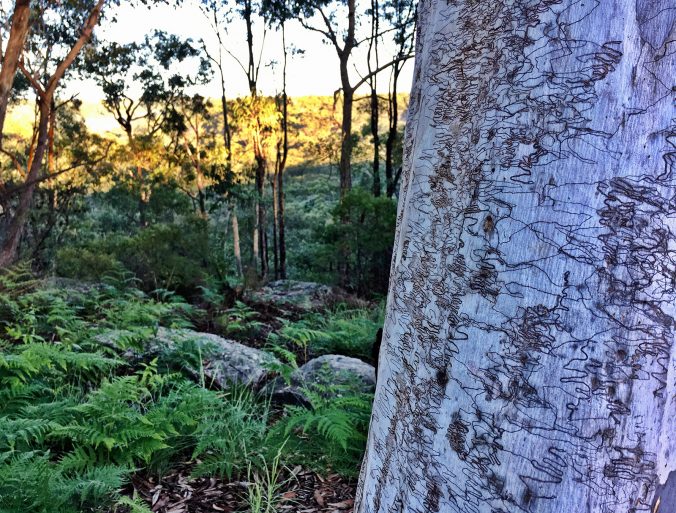The scribbly dialect zigzags around in a seemingly random and indecipherable pattern.
A standout feature of the spectacular forests of the Blue Mountains west of Sydney is the extensive stands of scribbly gum (Eucalyptus haemastoma), particularly in areas of poor soils on the typical sandstone country of the region. The trunk of each scribbly gum is a work of art fashioned by nature.
Scribbly gum is usually a small tree, frequently of very poor form 12 to 15 metres in height and 30 to 70 centimetres in diameter. On better sites in its northern distribution the tree may obtain a height of 25 metres. The tree has white or silvery grey bark, lance-shaped or curved adult leaves, flower buds in groups of between nine and fifteen, white flowers and conical or hemispherical fruit. It is one of three eucalypts with prominent insect scribbles in the bark.
Scribbly gum is usually found on the coastal areas of eastern Australia from Batemans Bay in southern NSW to Maryborough and Fraser Island in south eastern Queensland. However, it is most plentiful in areas a couple of hundred kilometres north and south of Sydney, and on the coastal belt of southern Queensland.
Scribbly gum commonly occurs as a principal species in poor open coastal forests of dry eucalypt forest and sometimes as pure stands on small areas of shallow soil. The most distinctive feature of this eucalypt is the ‘scribbles’ on the trunk, hence its common name. The iconic ‘scribbles’ on the smooth white trunks of Australian gum trees have intrigued many for years.
The scribbly dialect, which zigzags around in a seemingly random and indecipherable pattern, has found a place in Australian literature and culture. Yet the cause of the scribbles has been somewhat of a mystery. They are old and dry with no sign of their creator, no ‘graffiti tag’ to identify the artist. How and why they are present and what creature is responsible had long been a mystery.
The scribbles have caught the attention of writers and poets over the years. In 1955, Judith Wright wrote her poem ‘Scribbly Gum’
The gum-tree stands by the spring.
I peeled its splitting bark
and found the written track
of a life I could not read
Scientists and entomologist have now unlocked the mystery of the scribbly dialect made by moth larva tunnelling between the layers of bark.
Scientists and entomologists have now unlocked the mystery of the scribbly dialect made by moth larva tunnelling between the layers of bark. The life of a typical scribbly gum moth starts in autumn as an egg laid on the bark surface.
The hatching caterpillar burrows vertically down into the trunk then makes a 90 degree turn when it reaches the depth where next year’s cambium layer will form. It then starts on a zigzag culinary journey, always taking care to stay beneath bark that will be shed in the following year. As it grows the caterpillar sheds its skin several times – an insect skin is a hard shell and can only stretch so much before its owner needs a new, bigger one.
